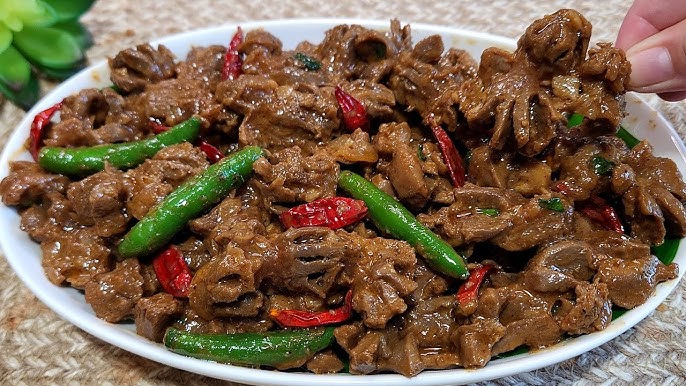Gizzard Recipe: Let’s kick things off with the basics. A gizzard is a part of the digestive tract found in birds, including chickens, turkeys, and ducks. It acts like a mechanical stomach, helping to grind up food with the aid of grit and stones. While this might not sound appetizing at first, trust me—when prepared correctly, gizzards are a culinary treasure.
Gizzards are dark meat with a dense, chewy texture that turns irresistibly tender with the right cooking methods. In many cultures, they’re considered a delicacy, and you’ll find them featured in everything from street food skewers to gourmet dishes. Whether fried, stewed, or grilled, they soak up flavor like a sponge and offer a satisfying bite that meat lovers adore.
Why Gizzards Are a Hidden Gem in the Kitchen
Many people overlook gizzards because they’re unfamiliar or deemed too “different,” but that’s a big mistake. First off, they’re incredibly affordable—perfect for families cooking on a budget. Second, they’re rich in protein, low in fat, and packed with essential nutrients. And finally, their unique texture and rich flavor can elevate almost any dish.
If you’ve never cooked with gizzards before, this guide is your golden ticket. We’ll walk through everything from cleaning and prepping to seasoning and cooking. By the end, you’ll be ready to whip up a mouthwatering gizzard dish that’ll leave your guests begging for seconds.
Benefits of Eating Gizzards
Nutritional Value
Gizzards aren’t just tasty—they’re also a nutritional powerhouse. They’re rich in protein, essential for muscle repair and growth. A single serving of cooked chicken gizzards (about 100 grams) contains roughly:
- 30 grams of protein
- Less than 3 grams of fat
- Zero carbs
But that’s not all. Gizzards are also packed with important vitamins and minerals, including:
- Iron – crucial for red blood cell production
- Zinc – supports immune function
- Phosphorus – vital for strong bones
- Vitamin B12 – helps keep your nervous system healthy
Eating gizzards regularly can support a well-rounded, nutrient-rich diet—especially if you’re trying to cut down on carbs or increase your protein intake without splurging on expensive cuts of meat.
Affordable and Versatile
Let’s face it—meat prices have skyrocketed in recent years. Gizzards, however, remain one of the most budget-friendly protein options out there. You can usually snag a pound of gizzards for a fraction of what you’d pay for chicken breasts or thighs.
Not only are they cheap, but they’re also endlessly versatile. You can fry them, boil them, sauté them with veggies, or throw them into stews and curries. Their ability to absorb spices and flavors makes them a go-to ingredient in kitchens around the world—from African pepper soup to Southern fried gizzards and Asian stir-fries.
Choosing the Right Gizzards
Where to Buy Fresh Gizzards
You can find chicken gizzards at most major grocery stores, usually in the poultry section. If you’re after ultra-fresh or organic options, check your local butcher or farmers’ market. Asian and Latin grocery stores also tend to carry gizzards year-round.
Pro Tip: Always check the “sell-by” date and avoid packs with excessive liquid or a foul odor—these are signs the gizzards may be past their prime.
How to Select Quality Gizzards
When shopping for gizzards, keep an eye out for these quality indicators:
- Color: Fresh gizzards should be deep purple or reddish with a slight sheen.
- Texture: They should feel firm and plump, not slimy or mushy.
- Smell: Fresh gizzards have a mild, meaty smell—not sour or fishy.
If you’re buying in bulk, inspect a few pieces before committing. And if you’re buying frozen gizzards, make sure they’re sealed properly with no signs of freezer burn.
How to Clean Gizzards Properly
Step-by-Step Cleaning Guide
Cleaning gizzards might seem intimidating, but once you get the hang of it, it’s a breeze. Here’s how to do it step-by-step:
- Rinse: Start by rinsing the gizzards under cold running water.
- Cut: Slice each gizzard lengthwise using a sharp knife.
- Remove Inner Membrane: You’ll notice a tough yellowish-white membrane on the inside. Gently peel this off—it’s not pleasant to eat.
- Trim Fat and Gristle: Use kitchen shears or a knife to cut away any extra fat or connective tissue.
- Soak (Optional): Some cooks prefer to soak the cleaned gizzards in vinegar or saltwater for 15–30 minutes to tenderize them and remove any lingering odors.
Tips to Remove Tough Membranes
This is the part most people dread, but it’s also the most important. The membrane inside the gizzard is rubbery and doesn’t soften much during cooking. To get the best texture:
- Use your fingers to pull it away from the flesh slowly.
- If it resists, use the tip of a paring knife to loosen an edge, then peel it back.
- Rinse each piece thoroughly again after removing the membrane to wash away any grit or debris.
Ingredients Needed for the Gizzard Recipe
Main Ingredients
Here’s a basic list of what you’ll need for a simple yet flavorful gizzard recipe (serves 4):
- 1 lb chicken gizzards
- 1 onion (chopped)
- 2 cloves garlic (minced)
- 1 bell pepper (sliced)
- 1 tsp paprika
- 1 tsp black pepper
- 1 tsp salt
- 1 tsp thyme
- 1 tbsp soy sauce
- 2 tbsp vegetable oil
- 1 cup chicken broth (or water)
Optional Add-ons for Extra Flavor
Want to kick things up a notch? Consider adding:
- 1 tsp curry powder for a warm, spicy note
- A splash of vinegar or lemon juice for tang
- A dash of hot sauce for heat lovers
- Sliced mushrooms or diced tomatoes for a richer stew
These extras can elevate the dish and help you customize the flavor profile to suit your taste.
How to Cook Gizzards – Step-by-Step Instructions
Step 1: Parboil the Gizzards for Tenderness
Cooking gizzards straight out of the package can result in a tough, rubbery texture. To make them tender and juicy, you need to parboil them first. Here’s how:
- Place the cleaned gizzards in a large pot.
- Add enough water to cover them completely.
- Toss in a pinch of salt and bring the water to a boil.
- Lower the heat and let them simmer for 45 minutes to 1 hour.
This pre-cooking step helps break down the fibrous texture and infuses the gizzards with initial seasoning. The longer you simmer, the more tender they become. For an extra flavor boost, add a bay leaf or a piece of ginger to the boiling water.
Once done, drain and set the gizzards aside. They’re now ready for the next stage of cooking, where all the flavor magic happens.
Step 2: Sauté the Aromatics
Now it’s time to build the flavor base. Grab a large skillet and heat 2 tablespoons of vegetable oil over medium heat. Add chopped onions and let them cook until translucent—around 3 to 5 minutes. Then, throw in the minced garlic and sliced bell peppers.
Sautéing the aromatics helps release their oils and aromas, giving your dish a deliciously savory backbone. This is also the point where your kitchen will start smelling incredible—just a taste of what’s to come.
Stir in your spices: paprika, thyme, black pepper, and a bit more salt if needed. Let the spices bloom in the hot oil for about a minute. This toasting enhances their depth and warmth, ensuring that every bite of gizzard is packed with flavor.
Step 3: Add the Gizzards and Simmer
With your spice mix ready, add the parboiled gizzards to the skillet. Stir well to coat them evenly with the aromatic mixture. Cook for about 5 minutes, letting the gizzards soak up all those delicious flavors.
Next, pour in the chicken broth or water and reduce the heat to a low simmer. Cover the pan and let everything cook together for another 20 minutes. This step locks in flavor while making the gizzards even more tender and juicy.
If you’re going for a stew-like consistency, let the broth reduce a bit. If you prefer a drier, stir-fry texture, simmer uncovered until the liquid evaporates.
This is also the time to add your optional ingredients—like mushrooms, tomatoes, or a dash of hot sauce. Play around with flavors here. Gizzards are like culinary sponges—they absorb everything beautifully.
Step 4: Taste and Adjust Seasoning
Tasting is crucial in any recipe, especially one with bold spices. Before serving, give the dish a final taste. Add more salt or pepper if needed. If you like it spicy, a splash of hot sauce or a sprinkle of chili flakes can turn up the heat.
Want a pop of brightness? A squeeze of lemon juice or a handful of chopped fresh herbs like parsley or cilantro can bring everything together.
Let the dish rest for a few minutes after cooking. This helps the flavors settle and makes your gizzards even tastier. And remember—leftovers taste even better the next day, so don’t be afraid to make a big batch.
Serving Suggestions
Best Ways to Serve Gizzards
Now that your gizzards are cooked to perfection, it’s time to serve them up. The great thing about gizzards is their versatility—they go well with a variety of sides. Here are some serving ideas:
- With rice: Plain white rice, fried rice, or jollof rice makes a hearty combo.
- With mashed potatoes: Creamy mashed potatoes pair beautifully with the rich gizzard sauce.
- Over pasta or noodles: A slightly unexpected but tasty twist.
- In a sandwich: Toss gizzards in a bun with slaw and spicy mayo for a unique, street-food-style snack.
- As an appetizer: Serve skewered and grilled gizzards with dipping sauces for party bites.
You can also enjoy them cold in a salad or reheated in a wrap. No matter how you serve them, gizzards always add a satisfying, meaty bite.
Common Mistakes to Avoid When Cooking Gizzards
Cooking gizzards isn’t rocket science, but there are a few common pitfalls you’ll want to avoid:
- Skipping the parboil: This leads to tough, chewy gizzards that are hard to enjoy.
- Under-seasoning: Gizzards have a bold flavor and need strong seasoning to shine.
- Overcooking during the final simmer: After parboiling, they just need time to absorb flavor, not to be boiled into oblivion.
- Not removing the inner membrane: This is a rookie mistake that affects texture big time.
- Using low heat throughout: Initial high heat during sautéing helps develop richer flavors.
Avoiding these mistakes ensures you end up with a dish that’s both tender and packed with flavor. Gizzards are forgiving, but a little care goes a long way in making them exceptional.
Storing Leftover Gizzards the Right Way
Refrigeration Tips
Leftover gizzards can make for a delicious second meal if stored properly. To keep them fresh and safe to eat, follow these simple steps:
- Cool before storing: Let the gizzards come to room temperature before placing them in the fridge.
- Use airtight containers: This prevents them from drying out and keeps the flavors locked in.
- Refrigerate within 2 hours: Don’t leave gizzards sitting out, especially in warm environments.
Properly stored, cooked gizzards will last about 3 to 4 days in the refrigerator. When reheating, make sure they’re warmed through completely—preferably on the stove or in the oven to retain texture. Microwaving is fine too, but it can sometimes make the meat rubbery.
Freezing for Long-Term Use
Yes, gizzards freeze beautifully. Here’s how to do it right:
- Cool completely before freezing.
- Use heavy-duty freezer bags or airtight containers.
- Label with the date so you know how long they’ve been stored.
Frozen cooked gizzards can last up to 3 months. To reheat, let them thaw overnight in the refrigerator and then warm them in a skillet with a splash of broth or oil to revive their juicy texture.
Health Precautions to Keep in Mind
While gizzards are nutritious, a few health precautions will ensure they remain safe and enjoyable:
- Cook thoroughly: Gizzards should reach an internal temperature of 165°F (75°C) to kill any harmful bacteria.
- Clean properly: Never skip the cleaning step; the inner lining and any grit should be removed.
- Avoid cross-contamination: Use separate cutting boards and knives for raw gizzards and other foods.
- Moderation: Though nutrient-rich, gizzards are also high in cholesterol. Eating them occasionally rather than daily is ideal, especially if you’re managing heart health.
By keeping these tips in mind, you’ll enjoy all the benefits of gizzards without any downsides.
Cultural Variations of Gizzard Recipes
Gizzards are enjoyed all around the world, each region adding its own twist:
- Nigeria: Gizzards are often cooked in spicy pepper sauce and served at parties as a popular “small chop.”
- Philippines: Known as “adobong balunbalunan,” gizzards are simmered in soy sauce, vinegar, garlic, and bay leaves.
- United States (Southern style): Fried gizzards are seasoned, breaded, and deep-fried—crispy on the outside, tender inside.
- Brazil: Served with farofa (toasted cassava flour), they’re a staple in many traditional home-cooked meals.
- Japan: In yakitori shops, grilled chicken gizzards (sunagimo) are served skewered and lightly salted.
These diverse culinary styles show just how versatile and globally loved gizzards really are.
Why You Should Try Cooking Gizzards Today
If you’re looking for a new go-to protein that’s affordable, nutritious, and bursting with flavor, gizzards are your answer. They’re a blank canvas for flavors, easy to prepare once you get the hang of it, and perfect for both everyday meals and special occasions.
Cooking gizzards also helps reduce food waste by using the whole bird—an eco-friendly and sustainable practice. So next time you’re at the butcher or grocery store, don’t walk past the gizzards. Grab a pack, follow this guide, and treat yourself to something different, delicious, and deeply satisfying.
FAQs about Gizzard Recipe
Q1: What are gizzards?
Gizzards are a part of a bird’s digestive system, typically found in chickens and turkeys. They are muscular organs that grind up food and are known for their rich, meaty flavor and slightly chewy texture.
Q2: How do I clean chicken gizzards before cooking?
To clean gizzards, remove any attached fat or membranes, rinse thoroughly under cold running water, and soak them in a little vinegar or lemon juice to reduce odor and soften them further.
Q3: How long does it take to cook gizzards until tender?
Simmering gizzards over low heat for 45–60 minutes usually makes them tender. Alternatively, pressure cooking them can significantly reduce the cooking time to about 15–20 minutes.
Q4: Can I fry gizzards directly without boiling them first?
You can, but boiling or simmering them first ensures they are tender inside before you crisp them up in the fryer. Skipping this step may result in tough or rubbery gizzards.
Q5: What are the best seasonings for gizzards?
Gizzards pair well with garlic, onions, paprika, cayenne pepper, black pepper, thyme, and curry powder. You can season them to suit your flavor preferences or regional cuisine.
Q6: Are gizzards healthy to eat?
Yes! Gizzards are high in protein, low in fat, and rich in essential nutrients like iron, zinc, and vitamin B12. Just be mindful of how you prepare them to keep them healthy—avoid excessive frying.
Q7: Can I store cooked gizzards?
Absolutely. Store cooked gizzards in an airtight container in the refrigerator for up to 3 days, or freeze them for up to 2 months. Reheat gently to avoid drying them out.
Q8: What dishes can I make with gizzards?
Gizzards are versatile! Try them in stews, stir-fries, fried rice, kebabs, or serve them as a crispy appetizer or snack.
Q9: Why are my gizzards still tough after cooking?
They may need more time to cook. Gizzards are naturally tough and require slow simmering or pressure cooking to break down the muscle fibers for a tender bite.
Q10: Can I cook gizzards in a slow cooker?
Yes! Slow cookers are excellent for gizzards. Cook them on low for 4–5 hours or until fork-tender. Add your favorite spices and broth for rich flavor.
Conclusion
Gizzards may not be the first thing that comes to mind when you’re thinking of dinner, but they’re a true hidden gem in the culinary world. With the right preparation—from cleaning and seasoning to cooking and serving—you can transform this humble organ meat into a rich, flavorful, and protein-packed meal.
Whether you’re cooking for your family, trying something new, or simply working with a budget, gizzards deserve a place on your plate. They’re versatile, delicious, and packed with nutrients—what’s not to love?
So roll up your sleeves, grab those gizzards, and turn your kitchen into a flavor-packed adventure zone. Your taste buds (and your wallet) will thank you.



